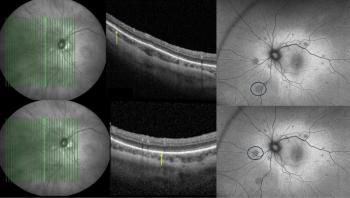
ESCRS 2023: Ace Vision Group presents scientific data focused on laser scleral microporation
The company has 9 presentations at the annual congress of the European Society of Cataract and Refractive Surgeons being held in Vienna. AVG also is a sponsor of the International Society of Presbyopia.
Ace Vision Group Inc. announced it will present nine sets of research on the effectiveness of laser scleral microporation (LSM) at the annual congress of the European Society of Cataract and Refractive Surgeons (ESCRS), being held through September 12 in Vienna.
The worldwide prevalence of presbyopia is forecast to peak at approximately 2.1 billion by 2030.1 LSM is an ultra-minimally invasive procedure with a novel therapeutic approach to treating the aging eye.
According to the news release, surgeons can help patients with presbyopia by restoring the age-related loss of dynamic range of focus (DRoF) with laser scleral microporation (LSM) is a therapy applied outside the visual axis to achieve eye rejuvenation. The company aloso noted an automated touchless Er: Yag laser creates tiny micropores in the sclera, uncrosslinking collagen and elastin fibrils, creating areas of biomechanical pliability. The treatment restores near and intermediate visual acuity without affecting distance visual acuity, according to the news release.
“We are thrilled to share the scientific research supporting the development and efficacy of the LSM procedure to help address the global prevalence and significance of progressive presbyopia,” AnnMarie Hipsley, DPT, PhD., founder and CEO of AVG, said in a news release.
“Improving the Dynamic Range of Focus (DRoF) for clear through focus vision at variable distances can enormously impact quality of life.” Mitch Jackson, MD, global medical director of Ace Vision Group, said in the news release.
Robust clinical research from AVG at ESCRS will include:
Dynamic Range of Focus Recovery in Emmetropic Presbyopes after Laser Scleral Microporation: 24 Month Pilot Study Outcomes, by Robert T. Ang, MD. et al.
According to the news release the study evaluates dynamic range of focus (DRoF) following bilateral Laser Scleral Microporation (LSM) in presbyopic eyes. Visual acuity data collected from 100 eyes of 50 participants demonstrated that LSM improved vision such that reading spectacles are generally unnecessary sustained over data collection period of 24 months.
Ang, who was the Principal Investigator for the LSM IRB Registered Study in Makati City Philippines noted in the news release there is an urgent need for a safe and effective treatment that is not affecting the patient’s normal vision.
Ang said regarding the 100 eyes of 50 patients who received the LSM therapy, “after almost two years of follow-up our patients are very happy and although they all respond differently, they are not using glasses for their normal daily activities.”
Evaluation of the Correlation of Depth and Visual Acuity After Laser Scleral Microporation in Presbyopic Eyes Utilizing AS-SS OCT by Luca Gualdi et al.
According to the company’s news release, his retrospective study determined the accuracy of real-time optical coherence tomography (OCT) guided LSM and evaluated the effects of depth on the efficacy of DRoF after LSM. Anterior segment swept-source OCT (ASS-OCT) measurements and automatic tissue segmentation (ATS) image processing were utilized as an optimization planning tool for the efficacy of the LSM procedure to verify and optimize the target depth, pore volume fraction, and total treatment.
Rejuvenation of Visual Age Utilizing a Novel Microporation Therapy to Uncrosslink the Sclera by Elizabeth Yeu et al.
The news release noted this study evaluated the loss of DRoF as a function of visual age and the potential for LSM to rejuvenate visual age in presbyopic eyes. The authors correlated the relationship between the DCNVA of presbyopic subjects, published expected DCNVA by age, and a proprietary formula to calculate "visual age" to determine the effects of uncrosslinking ocular rigidity using LSM.2 Results of 100 eyes of 50 patients showed a sustained visual age for 12 months of 15.4 years.
"After LSM, eyes were immediately 18.7 years younger in terms of visual age, and after one year, eyes were still over 15 years younger than at baseline," Elizabeth Yeu, MD, noted in the company's news release. "Our findings showed that LSM does provide sustained rejuvenation, demonstrating that age-related vision loss due to presbyopia is recoverable."
Prevalence and Impact of Vision Impairment of Uncorrected Presbyopia by AnnMarie Hipsley.
This interdisciplinary call to action is to revise the classification of presbyopia from a normal irreversible aging process with a responsive health promotion model of Ocular Health, Fitness and Prevention through awareness.
“This presentation covered a literature review as a collative report of published evidence on the burden of uncorrected presbyopia concerning prevalence and the socioeconomic impact on patient quality of life and gross domestic product,” the company said in the news release. “Key Strategies for Presbyopia Health Promotion and Awareness with specific reference to a plan of action for reducing ocular pathologies associated with presbyopia included recognizing the onset of presbyopia as a gateway to age-related ocular diseases and sight loss.”
The study revealed 1.8 billion people globally with presbyopia in 2022, 826 million of whom had near visual impairment and significantly reduced quality of life due to uncorrected presbyopia. Global unmet need for presbyopia correction in 2022 is estimated to be 42.9%.2
"The global prevalence of presbyopia represents a large unmet need due to lack of accessibility to ophthalmology services as well as the lack of interdisciplinary education, awareness, and educational constructs," Hipsley said in the news release. "The pathophysiological effects of the progressive loss of dynamic range of focus function on ocular health & longevity need to be identified and understood by the ophthalmic community."
Hipsley noted in the release that there is an urgent need for global health promotion and awareness for ocular health and fitness.
According to the company, additional presentations include:
- Therapeutic Approaches Addressing Loss of DRoF in Presbyopic Patients. Mitch Jackson et al.
- Virtual Clinical Trial Using A 3D Virtual Eye Simulation Analyzer to Predict Effectiveness of Laser Scleral Microporation for Progressive Presbyopia. AnnMarie Hipsley, et al.
- Clinical Strategies for Successful Evaluation of the Presbyopic Patient. James Katz, et al.
- Evaluating A Dose Algorithm for Laser Scleral Microporation (LSM) Therapy for Progressive Presbyopia Using A 3D Finite Element Predictive Model.
Laurent Sabatier et al. - Patient Reported Outcomes Assessed Using the Near Activity Visual Questionnaire of Presbyopic Subjects after Laser Scleral Microporation. Robert Ang et al
ISOP 2023
Ace Vision was also featured in six presentations at the annual meeting of the International Society of Presbyopia (ISOP), held September 7 in Vienna. Ace Vision is also a sponsor of the meeting.
References
1 Katz, J. Et al. Presbyopia – A Review of Current Treatment Options and Emerging Therapies. Clin Ophthalmol. 2021; 15: 2167–2178. Published online 2021 May 24. DOI 10.214/OPHTH.S259011.
2 Berdahl, J., Bala, C., Dhariwal, M., Lemp-Hull, J., Thakker, D., & Jawla, S. (2020). Patient and Economic Burden of Presbyopia: A Systematic Literature Review. Clinical ophthalmology (Auckland, N.Z.), 14, 3439–3450. DOI: 10.2147/OPHTH.S269597.
Newsletter
Get the essential updates shaping the future of pharma manufacturing and compliance—subscribe today to Pharmaceutical Technology and never miss a breakthrough.













































